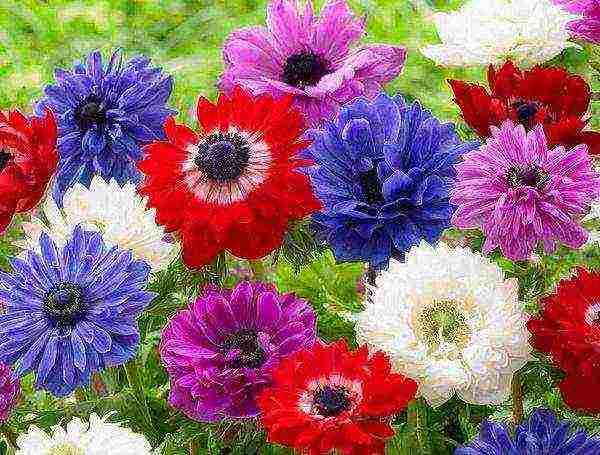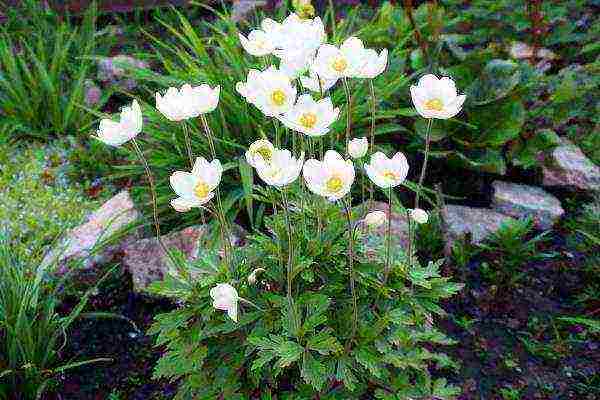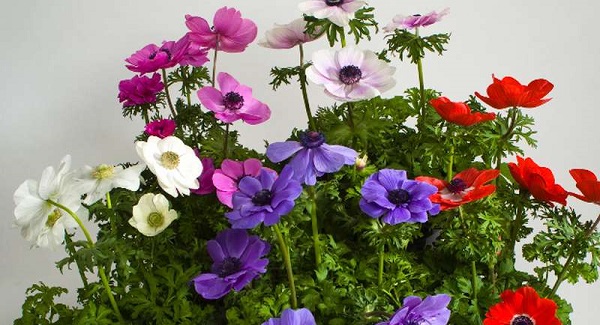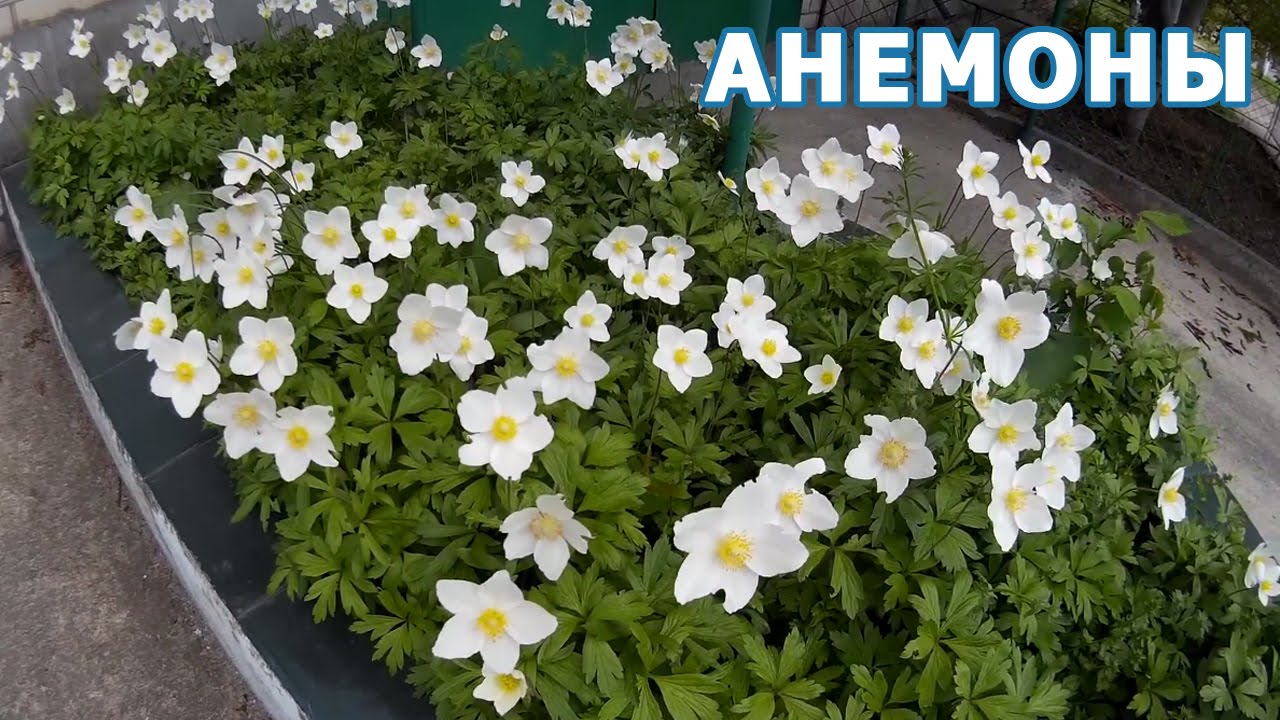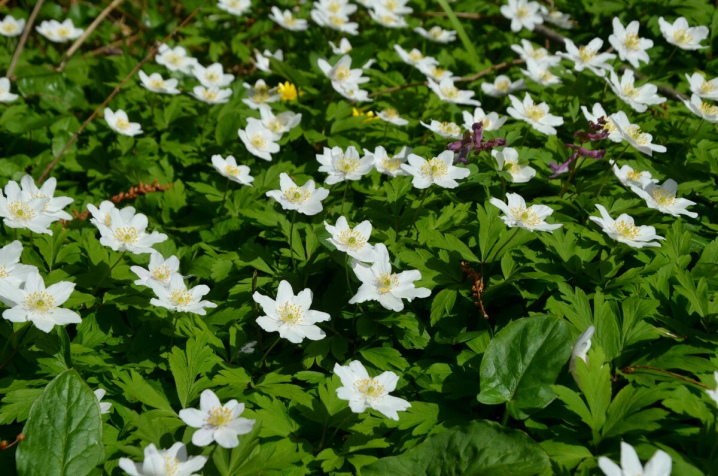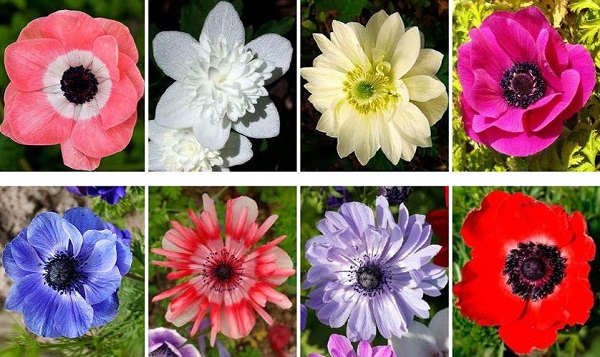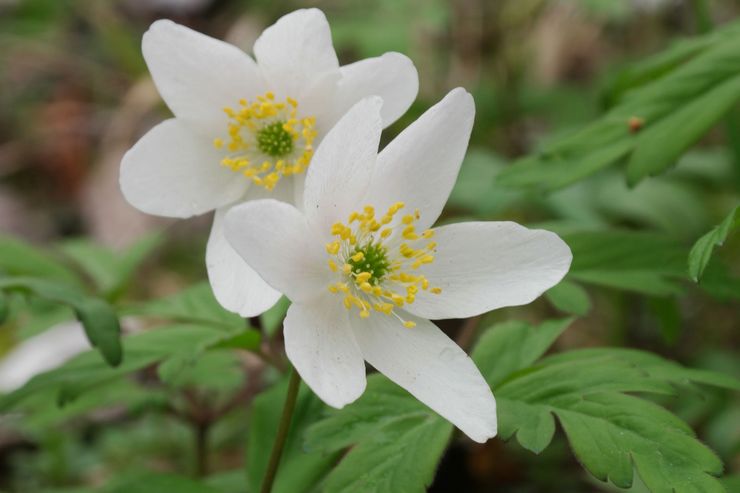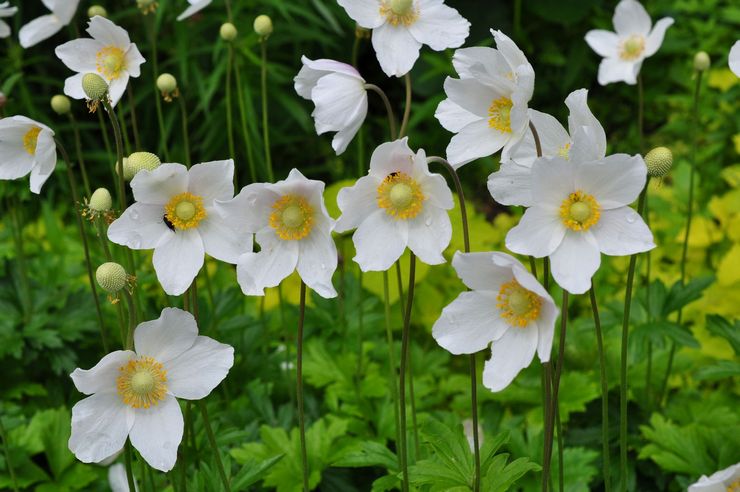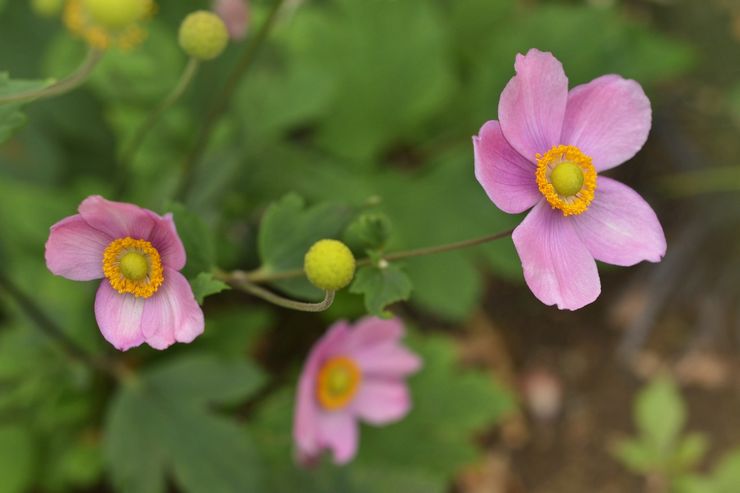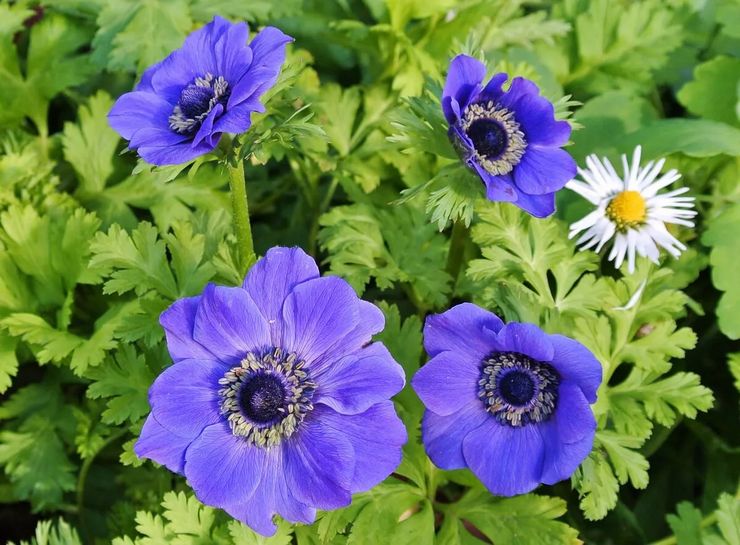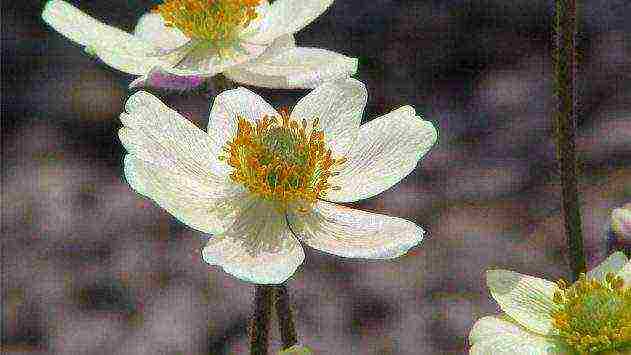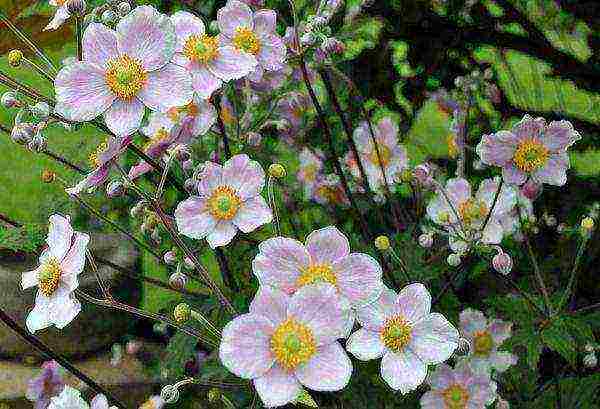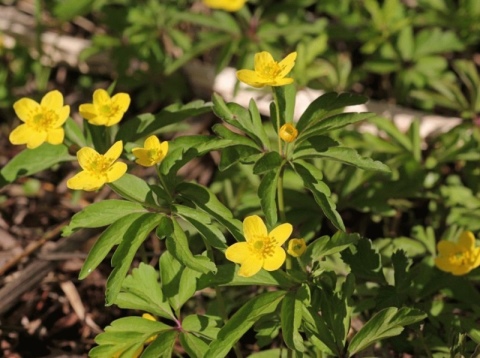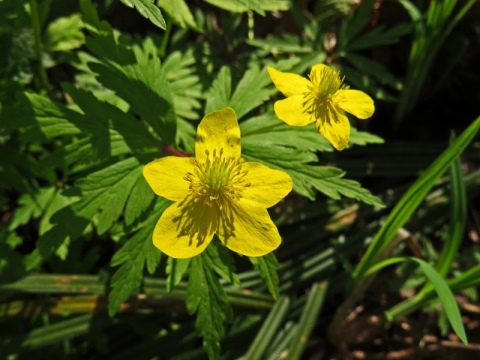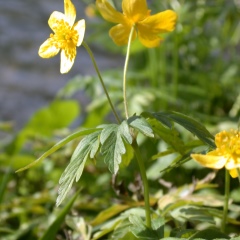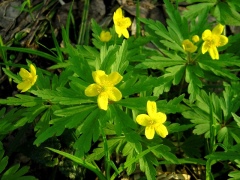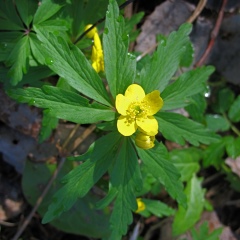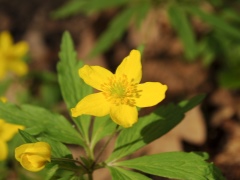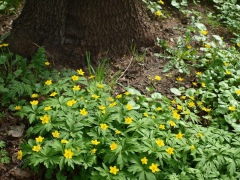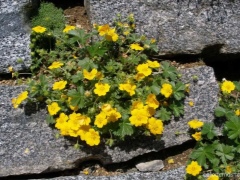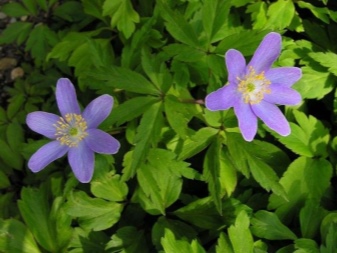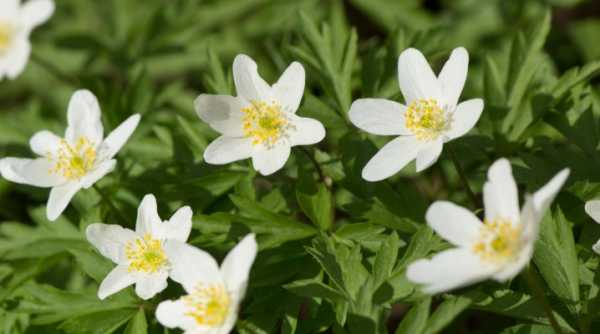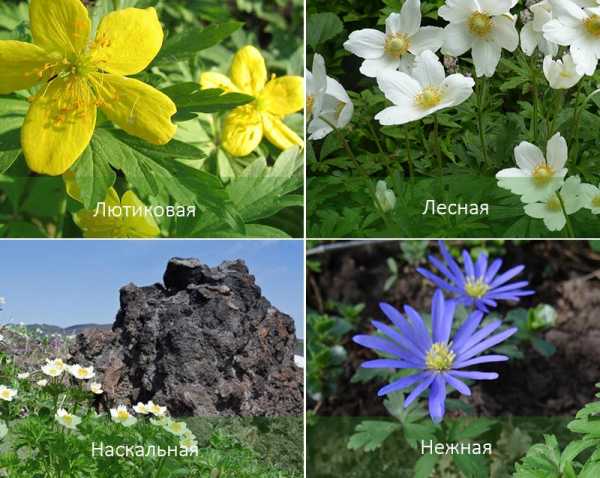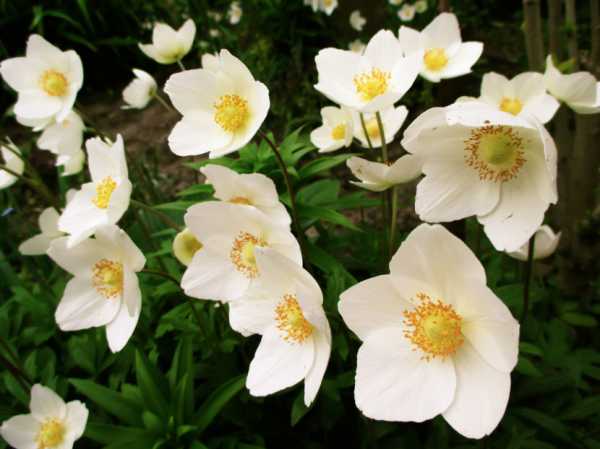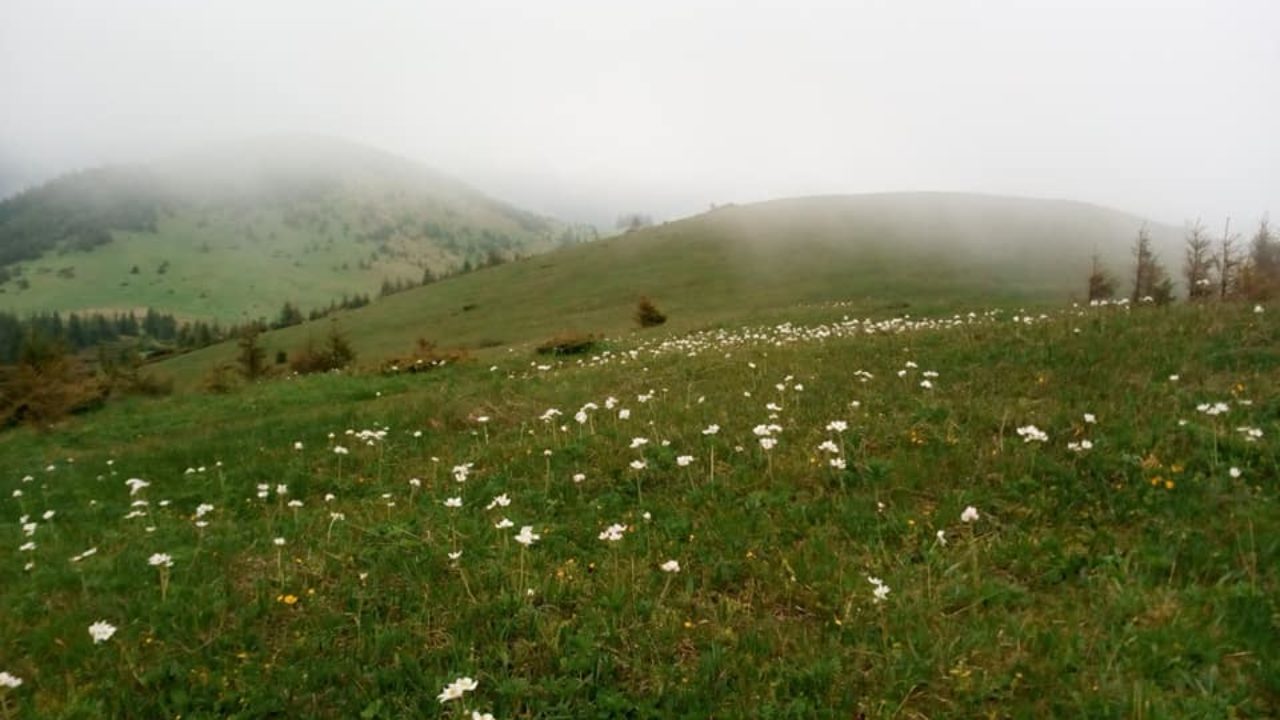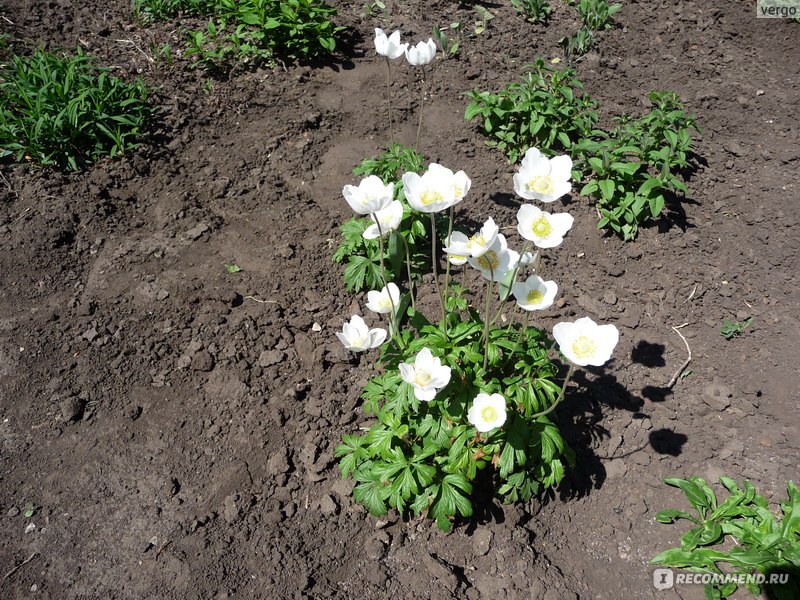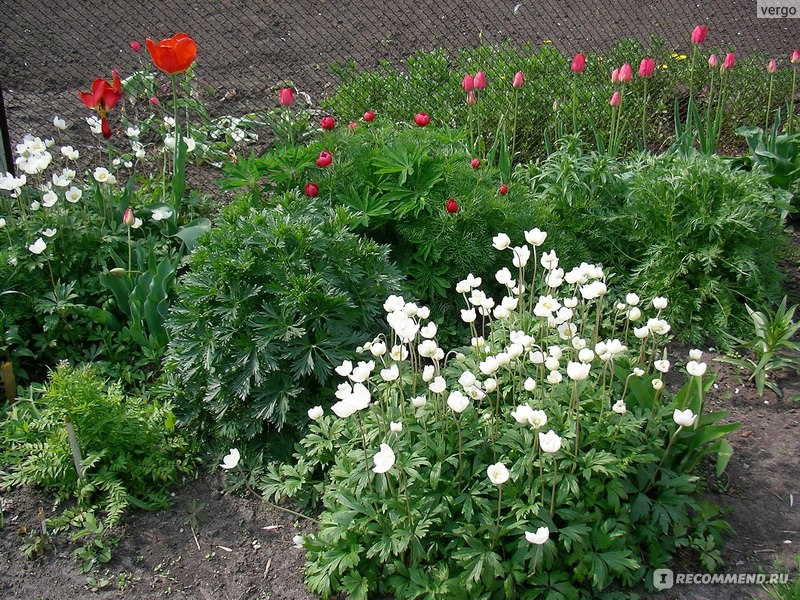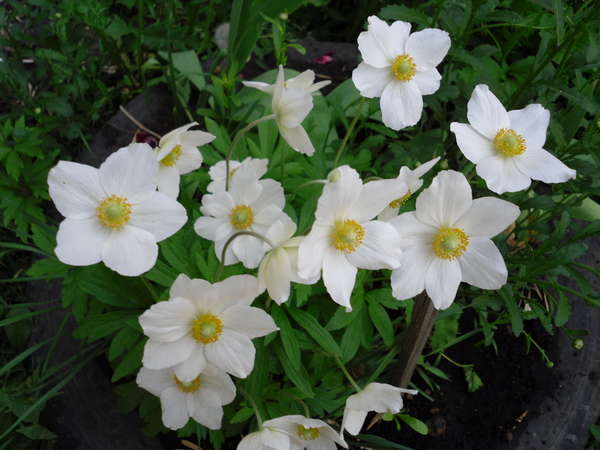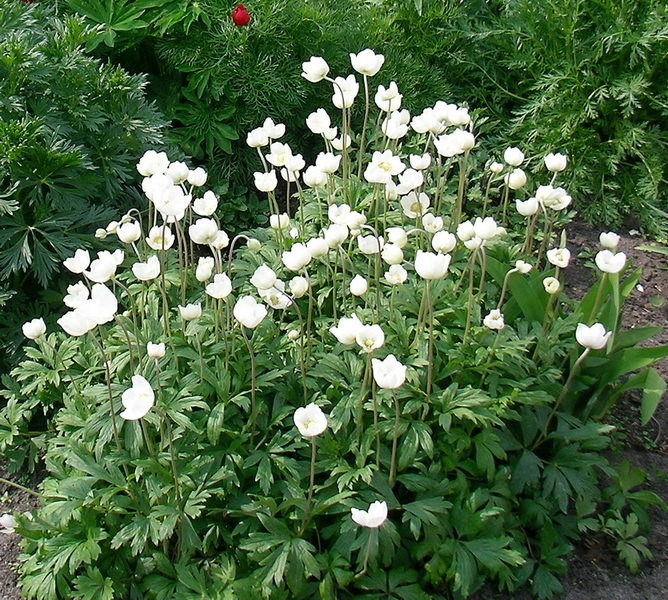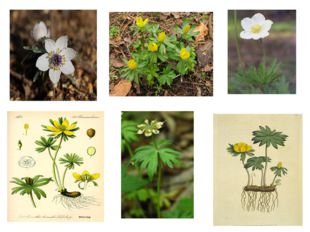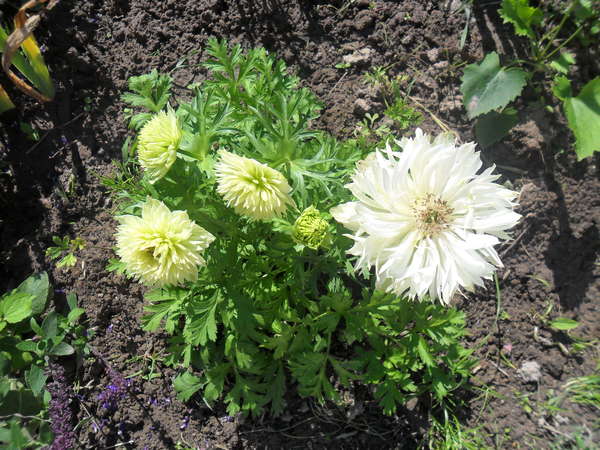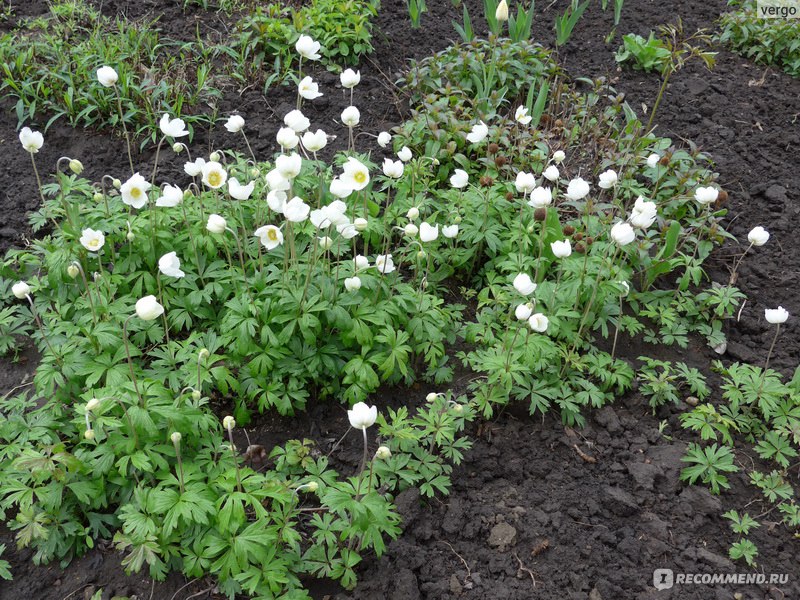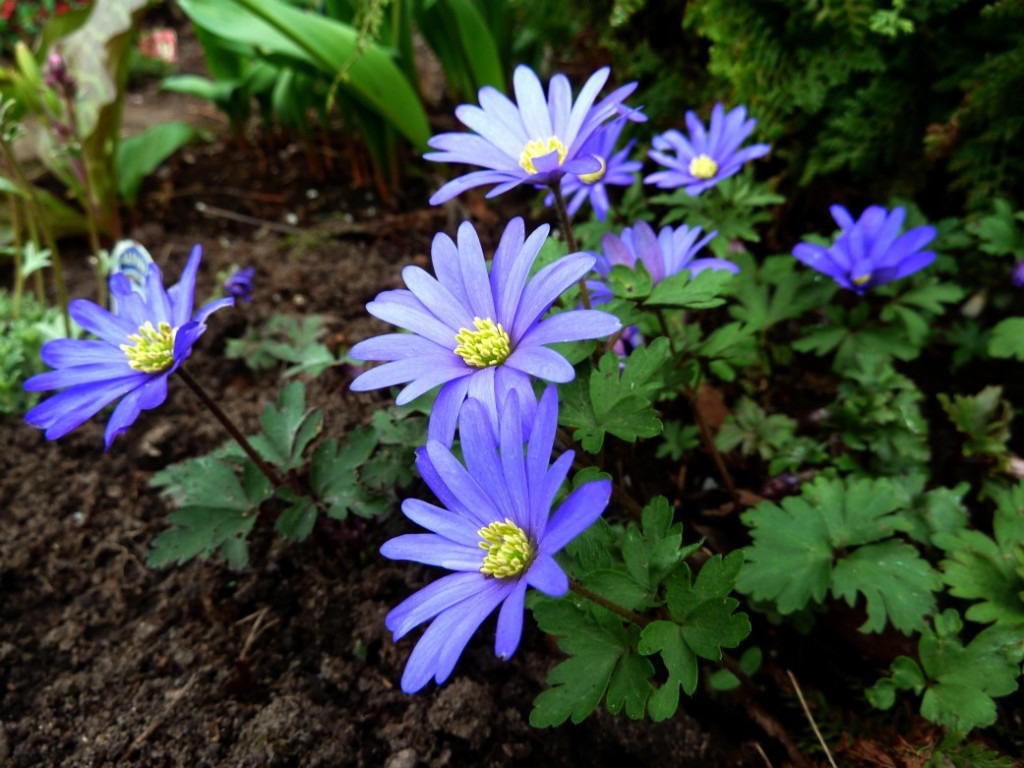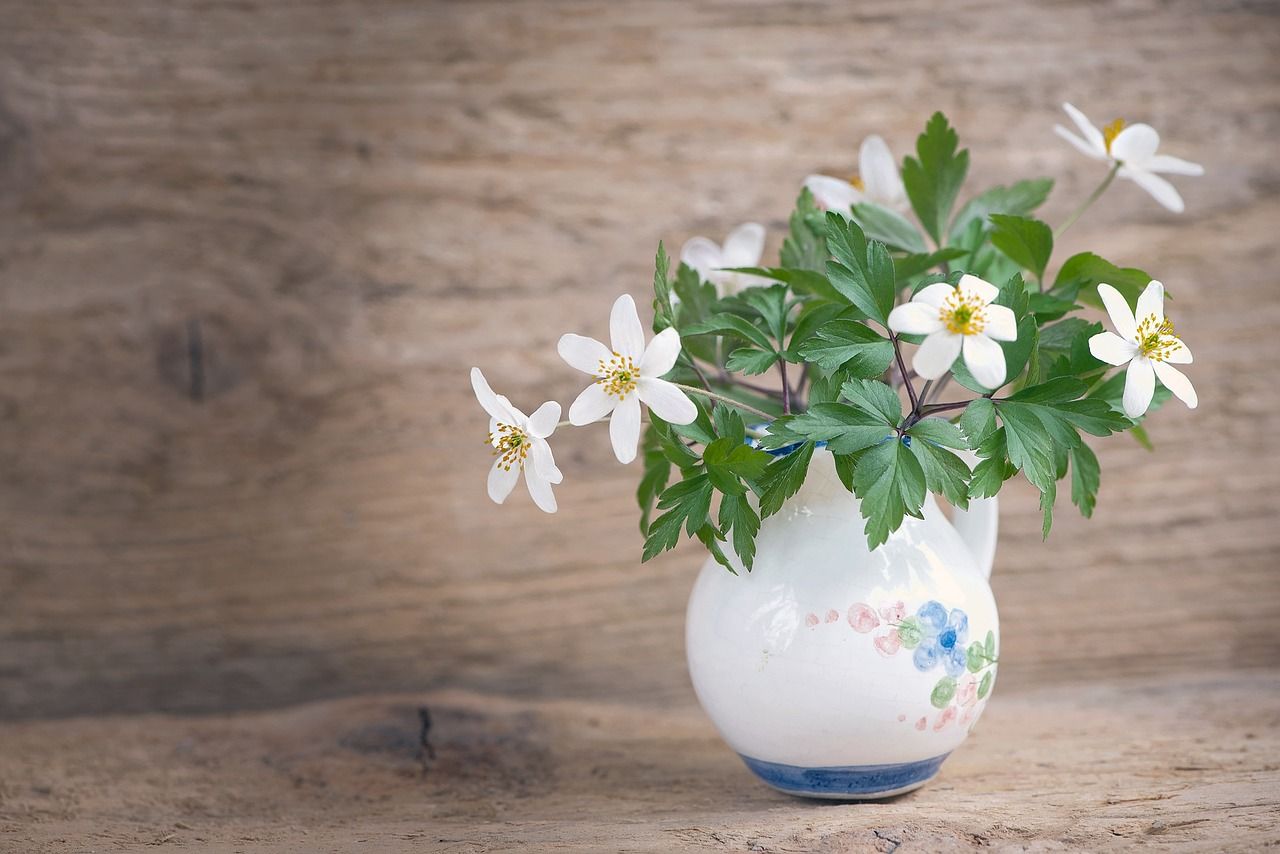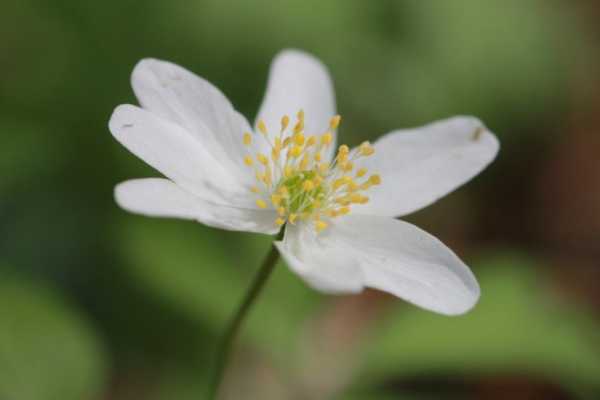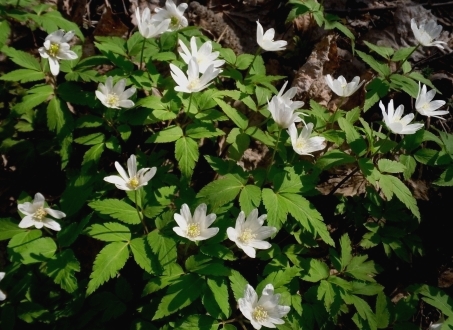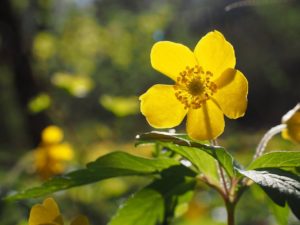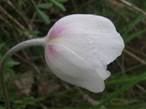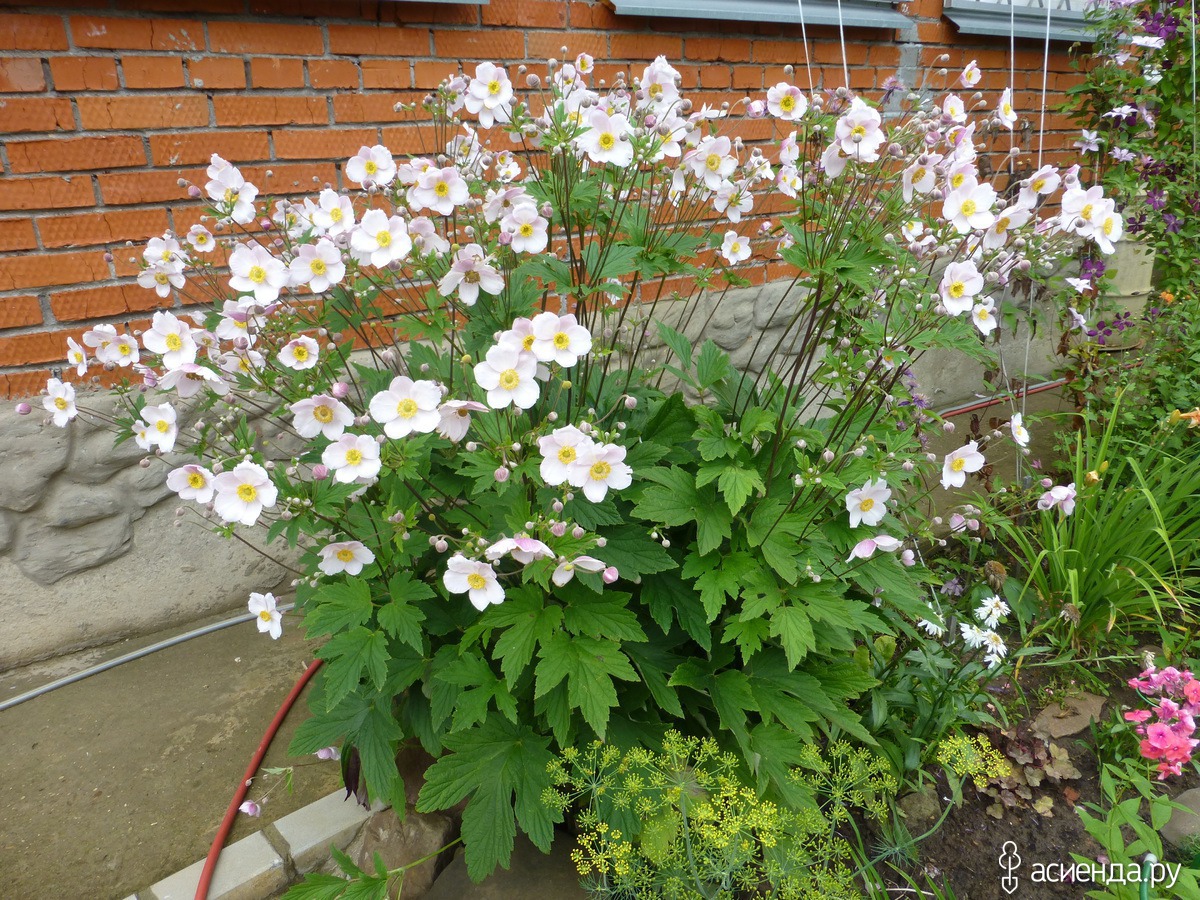Views
The genus anemone, or anemone (Anemone) (from the Greek "anemos" - "wind"), belongs to the family of buttercups (Ranunculaceae) and includes more than 150 different species.
Tender anemone (Anemone blanda) blooms in early May and blooms for about three weeks. This plant is mountainous, the distribution area is the Caucasus, the Balkans and Asia Minor. Prefers fertile moist calcareous soils. The root system of the tender anemone is a shapeless tuberous rhizome. From the buds of its upper part in the spring grow delicate stalks 15–20 cm high with beautifully dissected leaves. At the end of each stalk there is a "chamomile", a single inflorescence-basket with a diameter of up to 7 cm. The bush of the plant is graceful and airy. The flowers of the main species are blue-violet. Several dozen varieties have been bred with various flower colors: 'Charmé' - pink with a white center, 'White Splender' - white, 'Blue Shade' - blue.
The buttercup anemone (Anemone ranunculoides) is widespread in the light and humid forests of Eurasia. Its root system is a horizontal, creeping, highly branching rhizome. The plant grows into a dense curtain 20–25 cm high. At the ends of graceful peduncles there is a bract of three finger-dissected leaves and one or three bright yellow flowers up to 3 cm in diameter. Forms with double flowers and purple leaves have been introduced into ornamental gardening. Blooms in mid-May. The flowering period is about three weeks.
Blue anemone (Anemone caerulea) is native to the Sayan Mountains and southern Western Siberia. It also blooms in mid-May and blooms for two to three weeks. It also has a creeping horizontal rhizome, but the plant forms not dense, but looser clumps up to 20 cm high. For 3-4 years, its area can grow up to 30-40 cm in diameter. Straight peduncles bear at the end three carved palmate leaves and a single pale blue or white flower 1.5–2 cm in diameter.
The oak anemone (Anemone nemorosa) is widespread throughout the forest zone of Europe. She has a lot in common with the previous species. The same rhizomes, stem height, flower structure and flowering time. The main species has white flowers with a diameter of 3-4 cm. Less often, there are specimens with a creamy, greenish, pink or lilac color of the petals. In decorative floriculture, there are more than three dozen varieties with simple and double flowers. The most common of these is the 'Vestal' white terry variety. 'Robinsoniana' is a plant with chestnut-purple stems and lilac-pink flowers; ‘Blue Beauty’ - with bright blue large flowers and bronze leaves. The 'Virescens' anemone looks like a fantastic green flower, it has practically no corolla, and the lobes of the calyx are greatly increased.
Forest anemone (Anemone sylvestris) belongs to primroses. Its height is 20–50 cm. The distribution area is the north of Western and Eastern Europe, Siberia, the foothills of the Crimea and the Caucasus. This species loves to grow in bushes and on the edges of light forests. The root system is a vertical, rather powerful black rhizome. Basal leaves on petioles up to 20 cm long grow from the root collar in early spring. At the end of the first decade of May, peduncles with one or two large (up to 5–6 cm in diameter) white flowers rise from the rosettes. Sometimes the back of the petals has a slight purple tint. The forest anemone grows well - in 3-4 years its bush can reach 25-30 cm in diameter. In regular flower beds, you have to dig in a limiter to a depth of 20 cm to stop it from scattering. The forest anemone was introduced into the culture of gardening a very long time ago, from the XIV century. There are several varieties: ‘Wienerwald’ and ‘Elise Feldman’, sin. Plena 'with double flowers,' Fruhlingszauber 'and' Macrantha 'with large flowers up to 8 cm in diameter.
Rock Anemone (Anemone rupestris) is still rare in amateur gardens. This very beautiful species comes from the Himalayas, where it grows at an altitude of 2500–3500 m among shrubs and grasses.The experience of growing in the suburbs has shown that the rock anemone is unpretentious and easy to care for. The root system is a bunch of roots that penetrate the soil to a depth of 15 cm. From mid-May, purple peduncles 20-30 cm long appear from the rosettes. Each has up to three large flowers. On the back of the snow-white petals, there is an intense bloom of an inky purple color. Flowering lasts about a month. And then aerial stolons begin to grow, at the ends of which young rosettes are formed. However, this species does not grow very actively.
Common types
Buttercup
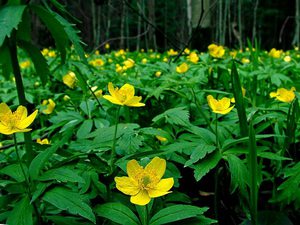 The buttercup anemone, along with the oak tree, is most typical for the European part of Russia. Shoots germinate at the very beginning of spring from a near-surface horizontal rhizome, due to which the plant spreads and forms whole clusters or spots. One, rarely two five-petalled yellow flowers bloom on a separate long peduncle. Blooms in spring: April or May. In July, leaflet fruits are already tied, which are then opened along the seam, releasing multiple seeds. When growing buttercup anemone in a garden plot, the following rules should be observed:
The buttercup anemone, along with the oak tree, is most typical for the European part of Russia. Shoots germinate at the very beginning of spring from a near-surface horizontal rhizome, due to which the plant spreads and forms whole clusters or spots. One, rarely two five-petalled yellow flowers bloom on a separate long peduncle. Blooms in spring: April or May. In July, leaflet fruits are already tied, which are then opened along the seam, releasing multiple seeds. When growing buttercup anemone in a garden plot, the following rules should be observed:
- plant in light partial shade;
- choose well-drained soil;
- acidic soils should be fertilized with dry lime;
- periodically thin out flower beds;
- water regularly, especially during the flowering period, but not excessively, since excess moisture damages the plant;
- apply mineral fertilizers during flowering.
Other types
 Crowned. Flowers of this species are similar to field poppies, but have a more accurate, noble shape. They also have a more varied color: red (like poppies), azure blue, snow white, pale purple or pinkish with multi-colored blotches and edging. This type of anemone has the largest flowers, reaching a diameter of ten centimeters. For an early and more lush flowering, you must:
Crowned. Flowers of this species are similar to field poppies, but have a more accurate, noble shape. They also have a more varied color: red (like poppies), azure blue, snow white, pale purple or pinkish with multi-colored blotches and edging. This type of anemone has the largest flowers, reaching a diameter of ten centimeters. For an early and more lush flowering, you must:
- soak the planting material in water for a while;
- Planting plants in well-drained soil
- avoid shaded areas;
- if the soil has an acidic reaction, it is necessary to neutralize it with dolomite flour.
White (oak). The main difference between this species and the widespread buttercup anemones is the white rather than yellow flowers, which have six to eight petals instead of five. The white anemone is also somewhat larger - up to 50 centimeters in height, against thirty in the buttercup. Oak anemone, due to its early flowering, is well suited for spring beds.
- Prefers sufficiently lit places.
- Feels better in rich alkaline soils.
- The soil should be loose and textured.
- For the winter, it is better to mulch flower beds with white anemone to prevent it from freezing.
Delicate. A low-growing species with a height of ten to twenty centimeters, with flowers of various shades of purple, less often pinkish and white. The shape of the petals of the flower gives it some resemblance to a chamomile. Flowering begins at a typical time for representatives of this species - in early spring.
Flowers and fruits
People often confuse garden buttercups, photos of which can be found in special magazines, and buttercup anemone. In fact, these flowers are very similar. Differences can only be noticed with a very close examination. So, the buttercup flower has a double perianth with sepals and petals. Anemone is the owner of a simple perianth, consisting only of petals, and sepals are absent. So the name "buttercups-flowers" to the anemone can only be used as a joke.
During the flowering of the buttercup anemone, there are almost no other plants. She belongs to primroses. It is light in the forest at this time, nothing shades it. Buttercups garden, the photos of which we have already discussed, bloom much later - closer to June. So it is rather difficult to confuse these types.
After flowering, the leaves of the buttercup anemone gradually turn yellow.By the end of spring, the forest is covered with foliage, other plants gradually appear and the anemone becomes dark. The yellowed buttercup anemone lies on the ground and dries up. At the beginning of summer, not a trace remains of it, but the superficial rhizome is alive.
The name of this beautiful and extraordinarily delicate flower comes from the Greek word "anemos", which means "wind". The flower petals of many varieties of this plant are so light and delicate that they crumble at the slightest breath of wind.

Lat. Anemone ranunculoides
A little later, she settled in some European countries, in the Caucasus, in Turkey, and now her varieties reach the east of the Urals. The people call the plant a buttercup, a goat, and for growing in damp and swampy places it was called a toad potion.
Who are the oak ephemeroids?
We are talking about a special ecological group, which includes herbaceous perennials, which have a too short growing season. The development of ephemeroids can occur at different periods. For example, the following types of ephemeroids are characteristic of spring: tulips, crocuses, snowdrops, anemone, corydalis and goose onions. And in the fall, there is a fleeting vegetation of the crocus.
Perennial ephemeroids are often confused with annual ephemera. Ephemeral vegetation time is also fleeting. But in the first case, the above-ground part of the plant completely dies off after the growing season, but the underground organs (rhizome or bulb) remain. In the second case, the plant bears fruit and dies off completely.
Application in medicine

Beautiful flowers, similar to buttercups, are used by gardeners not only to decorate the site, but also for treatment. Although the plant is classified as poisonous due to the content of toxic substances (tannin, resins, protoanemonin, saponins, ranunculin clicoside, camphor, etc.), in folk medicine, the medicinal properties of buttercup or buttercup anemone are widely used in the form of tinctures, decoctions, compresses and rubbing.
Pharmacological properties
The green parts of the plant have antimicrobial, antispasmodic and anti-inflammatory properties. In folk medicine, anemone is used for treatment in such cases:
- headache and toothache;
- stopping bleeding;
- whooping cough, asthma and rickets;
- removal of warts;
- rheumatism, sciatica, gout and edema;
- normalization of the bladder and kidneys;
- regulation of the female menstrual cycle;
- treatment of the liver, gallbladder, spleen.
Contraindications to the use of funds with anemone are the following diseases:
- cardiovascular;
- venous insufficiency;
- gastric and gastrointestinal diseases;
- allergic reactions of the body.
Folk recipes for remedies
The stems and leaves of anemone are used in the form of decoctions, tinctures, which can be taken orally, to make compresses and lotions.
Some popular recipes:
- A decoction of the leaves, used to reduce rheumatic pain in the joints, is prepared from 1.5 g of dried raw materials per glass of boiling water, infused for a day. For rubbing and compresses, an infusion is prepared from a bunch of stems and leaves (100 g), filled with 1 liter of vodka or alcohol, kept for 10-14 days, periodically shaken. A napkin is impregnated with a prepared strained infusion and placed on a sore spot; it must be covered with plastic wrap and a blanket on top, the action time is 1 hour.
- In diseases of the bladder, kidneys and gallstone disease, a decoction of 2 g of dry raw materials or 5 g of fresh is often used, which is poured into 200 ml of boiling water, insist in a thermos for 4 hours. Consume 20 minutes before meals three times a day.
- To get rid of insomnia and tinnitus, it is recommended to brew 1 tbsp. chopped herb anemone, pour 400 ml of boiling water, leave for 2 hours, then filter. Drink 1 tablespoon. 4 times a day.
- For the treatment of skin diseases (eczema, rash, purulent wounds), an infusion of 1.5 tsp is prepared. dry leaves and 300 ml of boiling water, kept warm in a thermos for 15-20 hours.Wipe the skin and purulent wounds with a cotton swab soaked in the infusion, and then dry.
- For colds and treatment of respiratory diseases, you need to prepare a decoction of 1 tbsp. crushed dried roots and 250 ml of hot water, simmer for 10 minutes, cool and filter. Drink 2 tablespoons. three times a day.
Procurement of raw materials for treatment can be done independently during the beginning of flowering of the anemone, in dry and clear weather.
Care for anemones
Caring for an anemone is simple and not burdensome. The main problem in this matter is maintaining the required moisture level throughout the entire growing season. The danger is that when waterlogged, the root system can die from rot. And the lack of moisture, especially during the period of bud formation, does not contribute to the growth and flowering of anemones. To balance moisture levels, plant the plants in an elevated, well-drained area.
After planting, it is very desirable to mulch the area with a five-centimeter layer of foliage of fruit trees or peat. As for watering, in the spring it is enough to moisten the soil once a week; in a moderate summer, the anemone does not need additional watering, the only exception is the crown anemone during the flowering period. In hot, dry summers, water daily in the morning or after sunset.
It is advisable to feed anemones during flowering with liquid organic matter (anemones do not like only fresh manure) and complex mineral fertilizers in autumn. If you fertilized the garden before planting the anemone, then top dressing can be excluded altogether. It is also recommended to regularly loosen the soil and weed out. Rather, do not weed, but break through with your hands, since you can damage the fragile root system of the anemone with a hoe.
Anemones are disease resistant; Sometimes they are harmed by slugs and snails, but a solution of metaldehyde will help you deal with these pests, which must first be collected by hand. Some anemones suffer from winter worms (caterpillars) or leaf nematodes. If a nematode is affected, it is better to destroy diseased plants, and replace the soil in which they grew.
Breeding anemone
Anemone propagates by seeds, tubers, dividing the rhizome or bush. We have already talked about reproduction by tubers and the most unpromising method, seed. When dividing the rhizomes, they (rhizomes) are dug out in the spring, cut into pieces 5 cm long with an obligatory bud at each segment and planted, placing horizontally in loose soil to a depth of 5 cm. Such a plant reaches maturity in three years. A dividing bush transplant can only be carried out with plants that are 4-5 years old.
Common species and varieties
The variety of species makes it possible for every gardener to choose a plant suitable for his garden. Many summer residents use a special trick: they plant different varieties of anemones on the site, which are characterized by completely different flowering periods. Thus, when some flowers pass into the dormant stage, others begin to “stay awake” with a riot of colors. As a result, the garden remains in bloom throughout the spring and summer period.
Altai
The habitat is a coniferous forest. In height, the stems reach about 25 cm. The root system belongs to the category of long. The anemone is characterized by single flowers, oval toothed leaves. The color of the flowers is predominantly white, with a diameter of about 6 cm. This protected species of anemone bears honey. It is actively used in medicine, due to the presence of anti-inflammatory and analgesic properties. Famous varieties: Everest, Governor.
Blue
The flowering period begins in late spring and lasts about a month. The characteristic features of this species are the ability to grow rapidly, the presence of a long rhizome and individual flowers. The size of the flowers is about 2.5 cm. The color is usually blue and white. The most popular are the Bride and Sylph varieties.
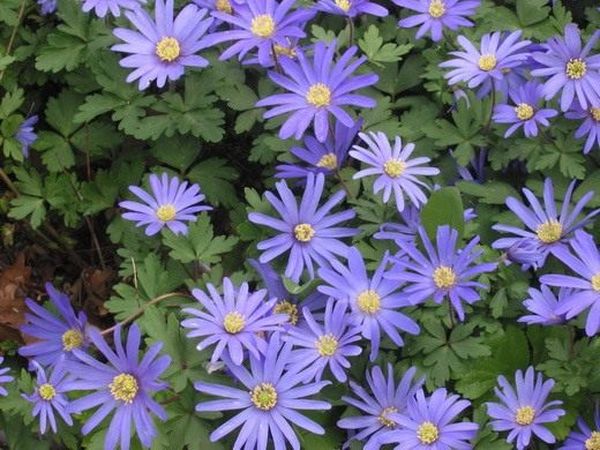 Blue and white anemone
Blue and white anemone
Hybrid
Blooms in late August - early October, lasts about one month. Numerous root suckers cause a very rapid growth of the culture. The stems of the hybrid anemone are quite high - up to 1.5 m. Flowers are large in size, up to 7 cm in diameter, have a double border.
The color gamut of the hybrid culture is wide: from pale purple to deep crimson. Anemone petals remain fresh until severe frost. The most popular varieties are Overture, Lady Glamor, Max Vogel.
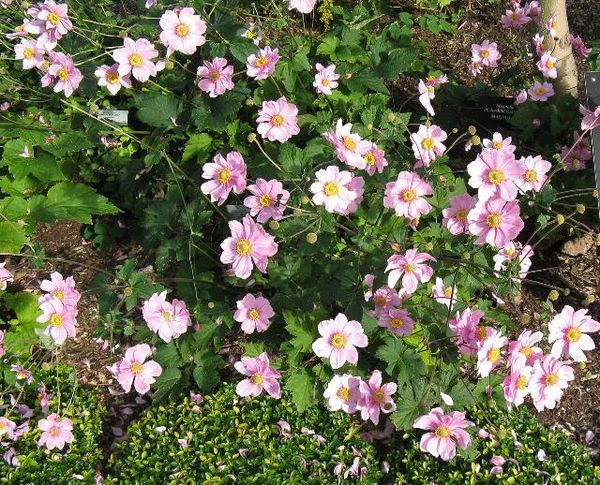 Hybrid anemone blooms in late August
Hybrid anemone blooms in late August
Dubravnaya
The lifespan of the terrestrial part of the plant is very short - less than a month. The oak culture reaches a height of 40 cm, therefore it belongs to the group of undersized. The flowers are mostly white and have a diameter of about 3 cm. The most popular varieties are Hilda and Vestal.
 Oak culture reaches a height of 40 cm
Oak culture reaches a height of 40 cm
Canadian
The growing season lasts the entire season. The plant is characterized by a strong root system that quickly forms fibrous shoots. Stems grow up to 50 cm, flowers are 4 cm in diameter. Inflorescences are white. Common varieties: Tony Spencer, Carolina.
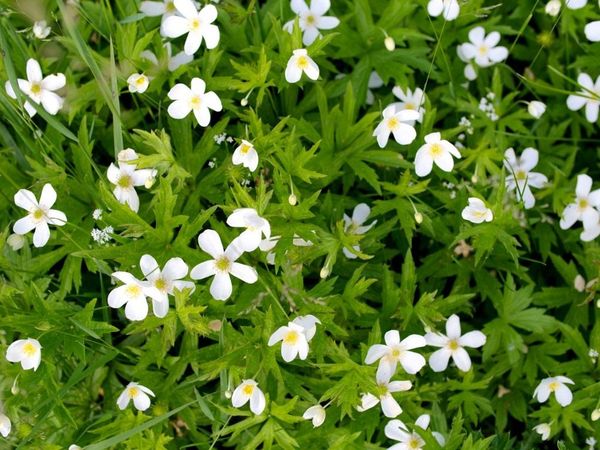 The growing season of the Canadian variety lasts the entire season.
The growing season of the Canadian variety lasts the entire season.
Crowned
It is characterized by poppy-like flowers, which are colored in red, lilac, pink shades. The stems grow up to 40 cm in length. The flowering period begins in early summer. In winter it needs shelter. Famous varieties: De Coyan, Don Juan, Lord Jim.
 Crowned variety of anemones
Crowned variety of anemones
Lesnaya
A low-growing culture, reaching a length of about 20-30 cm. It even adapts to critical conditions, characterized by the absence of a nutrient substrate and moisture. Winters without additional insulation. Among gardeners, the varieties Makranta, Eliz Feldman are in demand.
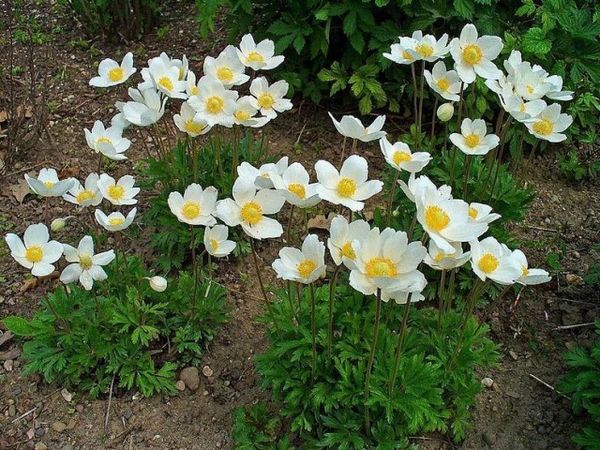 The forest variety overwinters without additional insulation
The forest variety overwinters without additional insulation
Buttercup
Flowering occurs in late spring and lasts about 25 days. The plant is undersized, reaches a length of 30 cm. The flowers are yellow, about 3 cm in diameter. The culture loves shaded areas of the garden, unpretentious in maintenance. Popular varieties: Pleniflora, Antiesen.
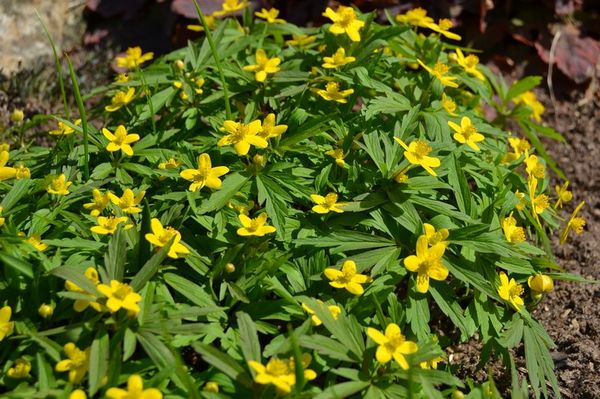 The lute variety blooms for about 25 days.
The lute variety blooms for about 25 days.
Rock
The homeland is the Himalayan mountains. The flowers are white with a lilac tint on the inside. Adapts to any soil. The plant easily tolerates a lack of moisture and light.
 The homeland of the rock species is the Himalayan mountains.
The homeland of the rock species is the Himalayan mountains.
Delicate
A low-growing culture, the length is 13 cm. Blossoms, as a rule, in mid-April for 2-3 weeks. Popular varieties: Charmе, Blue Shade, White Splender.
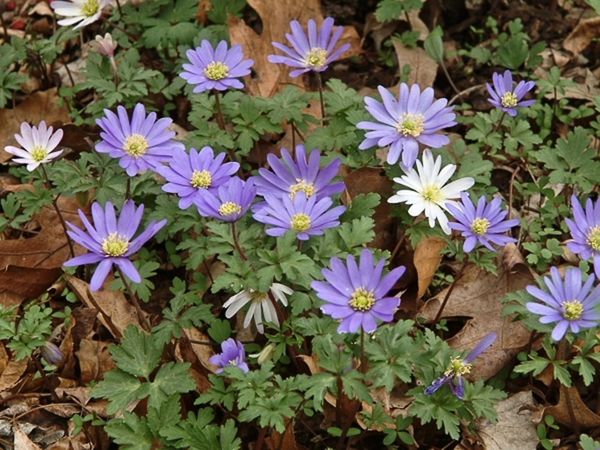 Tender is another type of anemone
Tender is another type of anemone
Japanese
The period of activity begins in the fall. The height of the crop is about 130 cm. Terry petals are a characteristic feature. In winter, it requires a reliable shelter. Popular varieties: Koenigin Charlotte, Prinz Heinrich, Wirbelwind.
 The Japanese anemone requires a secure shelter in winter.
The Japanese anemone requires a secure shelter in winter.
Growing and caring for a plant
One of the main advantages of an anemone is its incredibly attractive appearance. Even if you consider it risky to use this plant for treating diseases, you can simply plant anemones in your area and enjoy their beauty in early spring. Consider the basic rules for planting and caring for this herb.
Conditions of detention
The plant is successfully grown in open ground, it will become a worthy decoration of a summer cottage or any flower bed. Moreover, anemones bloom very earlywhen many other plants have not yet had time to wake up after winter. 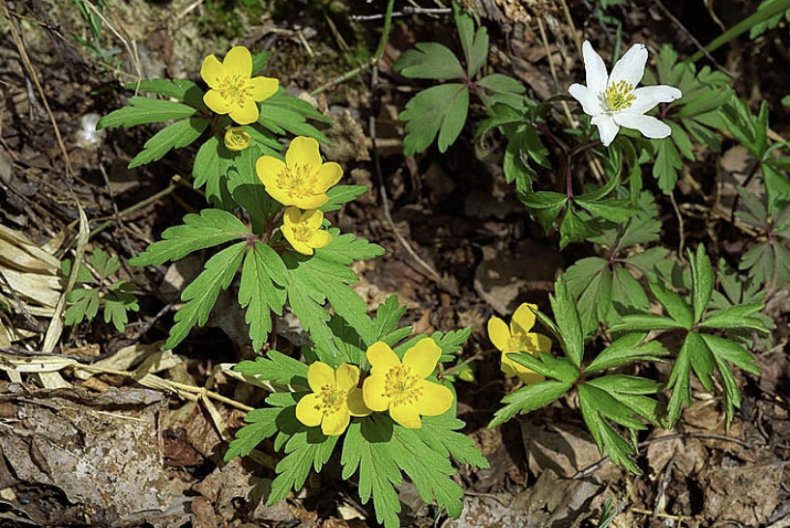 Buttercup anemone prefers light partial shade, so it is best to plant it between trees and shrubs. When choosing a place for planting, it is worth considering that the anemone grows very quickly.
Buttercup anemone prefers light partial shade, so it is best to plant it between trees and shrubs. When choosing a place for planting, it is worth considering that the anemone grows very quickly.
Soil and fertilizers
The soil for planting must certainly be light and well-drained, and also contain a large amount of humus. In order for the soil to meet these criteria, it is necessary to add a little river sand and small stones to the soil. Anemone does not like soil with high acidity, the optimal level for it is 7–8 pH. Lime is used to reduce the acidity of the soil.  Mineral complex fertilizers can be used as top dressing. They should be introduced during the flowering period.
Mineral complex fertilizers can be used as top dressing. They should be introduced during the flowering period.
Watering and humidity
Watering should be treated with caution, the anemone does not tolerate waterlogging, as, in fact, drying out the soil. Therefore, water procedures must be kept under control and carried out as the top layer of the soil dries out.
Relation to temperature
In moderate climatic conditions, the plant winters well in the ground. In late autumn, you need to mulch the soil around the plant with leaves, peat or humus by 2-3 cm and cover the plantings with spruce branches. But in the northern corners, where winters are very harsh, it is better not to leave the buttercup anemone to winter in the garden. It is recommended to dig out the rhizome and place it in a dark, cool place until the temperature returns to normal. In early spring, the plant can be returned to its original place.
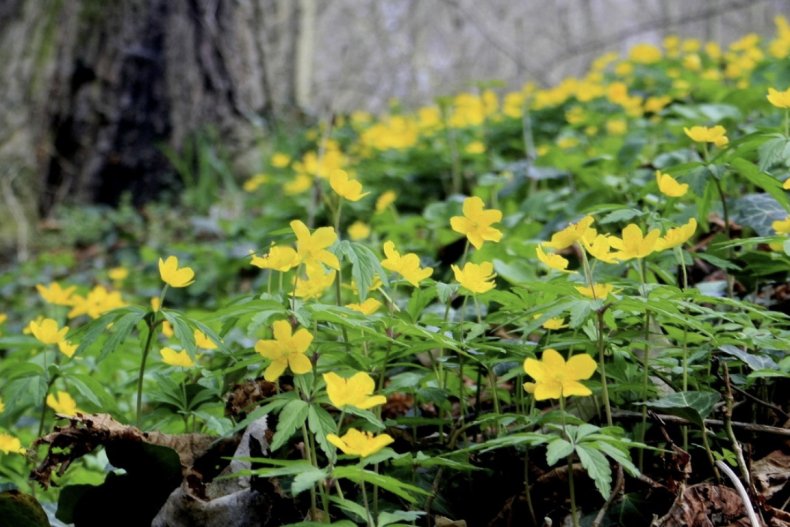
Reproduction
There are several ways to propagate buttercup anemone:
- Tubers - the plant has a strong and developed rhizome, which grows very quickly. In the spring, you can see young bushes with buds that are easy to replant. This method is the most successful.
- By dividing the root - in early spring, you can dig up the tubers of the plant and divide them into parts so that each division has a bud. Then the cuttings are planted in the ground to a depth of 5 cm, placing the rhizome horizontally.
- Seeds - this method is considered very troublesome and is rarely used by gardeners. Anemone seeds are sown before winter, but it should be noted right away that they do not have a high germination capacity.
Procurement and storage of raw materials
For the preparation of various medicines, both dried and fresh leaves of the plant are used. It is necessary to cut anemone only with gloves and avoid getting its juice on the skin. Then the foliage is either immediately grinded in a meat grinder and poured with alcohol, or dried in the open air or dried and packed in bags made of natural fabric.
Both alcoholic tinctures from fresh anemone leaves and dried raw materials should be stored in a dark, cool, well-ventilated area. The shelf life of this raw material is 24 months from the date of procurement. 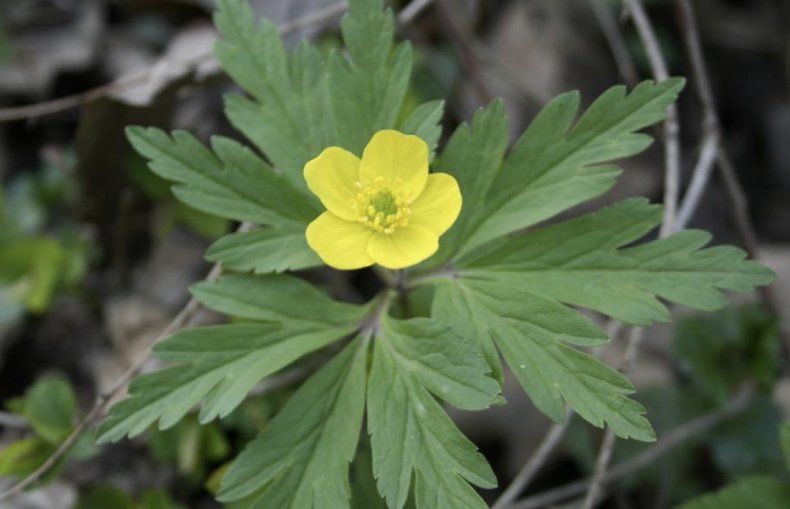
Possible growing difficulties
Subject to the rules of agricultural technology, problems with growing a plant are extremely rare. The main thing is to prevent waterlogging and drying out of the rhizomes, as well as to apply mineral fertilizers in a timely manner and dosed. In cold regions, it is necessary to dig up tubers for the winter, otherwise flowering will occur much later.
Pests, diseases and prevention
Anemone does not belong to the painful representatives of the flora, but even taking into account the high resistance to diseases, some problems can still arise. It happens that slugs infect a herbaceous plant. To combat them, it is enough to install a container with water with a high chlorine content. 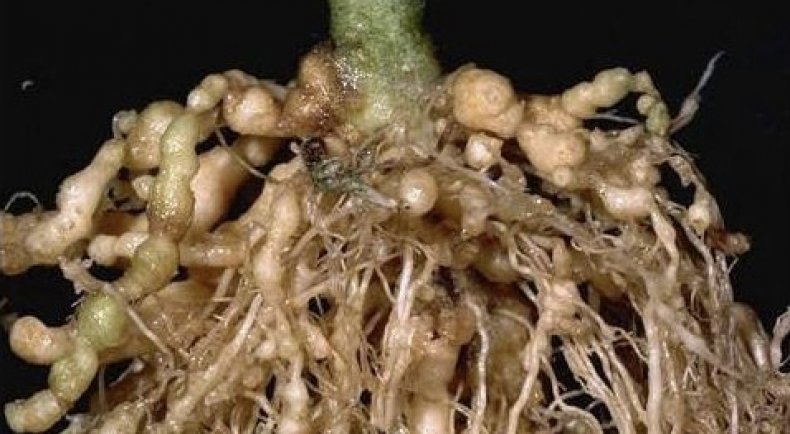 Plant affected by nematodes Sometimes the buttercup anemone is affected by nematodes, their harmful effect is directed at the rhizome, which becomes covered with spots, gets sick and dies. If such a problem is diagnosed, the plants are destroyed and the soil is disinfected.
Plant affected by nematodes Sometimes the buttercup anemone is affected by nematodes, their harmful effect is directed at the rhizome, which becomes covered with spots, gets sick and dies. If such a problem is diagnosed, the plants are destroyed and the soil is disinfected.
Now you know that a herb called buttercup anemone can be easily grown in your summer cottage. Its bright yellow flowers will be among the first to announce the arrival of spring and delight with their beauty. And if necessary, you can dry its foliage and use it as a medicine for various diseases.
Application in medicine
The herbaceous plant anemone buttercup is widely used in folk medicine, as it has many healing properties. This plant is able to relieve pain, inflammation and spasms. Also, anemone is used as an antimicrobial agent.
Alcohol tinctures from foliage are widely used. They are used as compresses and rubbing for various edema, and sometimes even for radiculitis.
To level the discomfort in the joints, you can use a decoction of the foliage. To do this, 1-1.5 g of crushed dried leaves are poured with boiling water and insisted for 10-12 hours.
The same remedy, only infused twice as long, can be used to treat skin rashes. If there are fresh wounds on the skin, it is impossible to wipe them with such an infusion.
We would like to note that the herbaceous plant anemone buttercup is poisonous
Therefore, the use should be carried out very carefully and under the supervision of a physician. Reactions are very often individual
In any case, this is only an addition to the main treatment, but not a panacea.

It is absolutely not worth using this flower for treatment if there are diseases of the gastrointestinal tract or heart, problems with veins or frequent allergic reactions. It is safest to use pharmaceutical preparations that include the described culture.
With joint pain
They use a decoction of the leaves, previously brewed in boiling water, and infused for one day. For a mug of boiling water, you must use 1.5 g of dry raw materials.
Put one and a half teaspoons of dry raw materials from anemone leaves in a full mug of boiling water, wrap it in a towel, or use a thermos. Leave on for 15 - 20 hours. Wipe clean skin with a tampon slightly moistened with this infusion, and after use do not wash. Do not use on open, fresh wounds. On festering wounds, do not apply a tampon in the form of a compress, but only wipe and dry immediately.
For 200 g of boiling water, use 2 g of dry leaves, or 5 g of fresh ones. Leave in a thermos for 4 hours, and drink 20 minutes before meals three times a day.
Traditional healers very often resort to the help of buttercup anemone in the treatment of various diseases, despite the fact that the plant is poisonous. Fresh anemone leaves contain such a toxic substance as anemonol, which, after drying the leaves, turns into an equally dangerous anemonin. In small doses, these substances do not pose a mortal danger, but if you go too far with the dosage, you can cause serious problems.
The benefits of anemone, which include, among other things, glycosides and camphor, are as follows:
- relieves headache and toothache;
- helps to stop bleeding;
- effective in treating warts and abscesses;
- used to treat whooping cough, rickets and asthma;
- normalizes kidney and bladder function;
- helps to improve the menstrual cycle in women;
- has a beneficial effect on the liver, gallbladder and spleen;
- effective for rheumatism, radiculitis, edema and gout.
The leaves, grass and rhizomes of anemone are used to make effective medicinal preparations and forms used in the treatment of many diseases. Let's consider the main ones.
Pour 1 cup of cold boiled water over 1 tsp. crushed dry leaves, leave for 24 hours, drain. Drink 1-2 sips 20 minutes before meals during the day with inflammation of the liver, cholelithiasis, inflammation of the spleen, kidneys and bladder - the daily norm.
Rhizome juice heals warts.
Description and characteristics of the plant
In common people, the Anemone is called "Wind", because at the slightest breath of wind it sways, and the stem with a bright yellow flower bends to the ground.
A strong, creeping rhizome, thanks to which the anemone grows, holds it, and the delicate, at first glance, fragile stem, even after a strong hurricane and rain, again takes a vertical position. Plant height 15 - 30 cm.
 Buttercup anemone
Buttercup anemone
Fingered, strongly dissected leaves, located high from the ground, in spring they have a very delicate, green color, and closer to the middle of summer, they darken. The plant, from the moment of planting seeds to flowering, can develop within ten years, and is very sensitive to the composition of the soil.
Siberia, the middle zone of Russia, the foothills of the Caucasus, Asia Minor, Central Europe are the growing areas where the anemone is generally widespread. Introduced artificially to the British Isles, it has somewhat changed nature and acclimatized.
Anemone is a poisonous plant, therefore, you need to use it as a remedy with great care, and only on condition that you know all the contraindications
Crowned
One of the most common types due to its very decorative appearance, the height of the stem is up to 50 cm. Beautiful bouquet groups are built from it, both from one species and in prefabricated bouquets. Flowers up to 8 cm in diameter. simple, or terry, can have all shades of blue and similar colors.
White or oak
A species that differs from the widespread yellow not only in color, but also in height. If the yellow anemone reaches a height of 30 cm, then the white one can be 50 cm. Gardeners are happy to use Dubravnaya anemone in spring flower beds.
A plant with a height of 10 - 20 cm with a delicate purple flower, or other similar shades, as well as pink and white. The long pointed petals of the flower make it look like a chamomile. It blooms, like most representatives, in early spring, and is widely used by gardeners.

